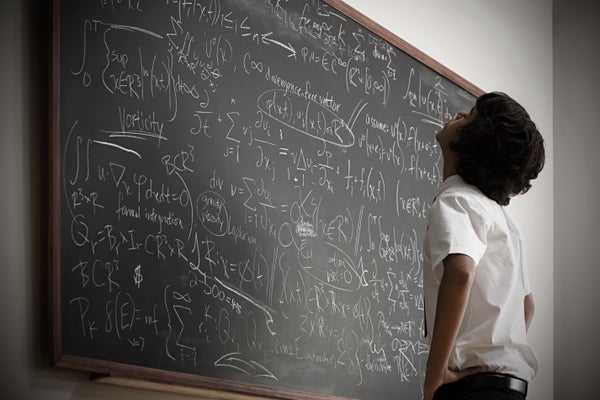This article was published in Scientific American’s former blog network and reflects the views of the author, not necessarily those of Scientific American
As a publicly mathematical person, one of the matters upon which I am called to adjudicate is what I think of as “viral order of operations questions” with a math problem along the lines of “48÷2(9+3) = ?”
In the past, I used to tell people who asked me about one of those questions something like, “I think the correct answer is __, but it’s better to write the expression unambiguously.” But recently I decided I need to put my foot down. I will no longer give an answer to those questions. The only way to win is not to play.
An ambiguous sequence of digits and mathematical operation symbols is not interesting to mathematicians. Most of us learn something about the order of operations fairly early on in our mathematical educations. We might learn PEMDAS or BIDMAS, or “Please excuse my dear aunt Sally.” All of these expressions tell us that we’re supposed to take care of expressions inside parentheses or brackets first, followed by exponential expressions, followed by multiplication and division, then addition and subtraction. It’s good that we have a system, but mathematicians and other people who use mathematical expressions regularly would never write down something like “48÷2(9+3) = ?” because its potential for causing confusion is too great.
On supporting science journalism
If you're enjoying this article, consider supporting our award-winning journalism by subscribing. By purchasing a subscription you are helping to ensure the future of impactful stories about the discoveries and ideas shaping our world today.
In general, mathematicians strive to reduce ambiguity when possible. A mathematician would write (48÷2)(9+3) or 48÷(2(9+3)), depending on which one they meant. Viral order of operations problems are unappealing. Just toss in a few more parentheses to clarify your meaning and move on. There are cat pictures to scroll through, for goodness’ sake!
In fact, I think if mathematicians had their way, they would get rid of easily-fixed ambiguous order of operations problems altogether, and I don’t think they’d stop there. The English language often leaves room for ambiguity, and I think mathematical notation could help us make some improvements.
I remember chuckling to myself when I saw the phrase “I like to play board games and read a book while taking a bath.” It conjures up an image of a very exciting game of Monopoly where Baltic Avenue is replaced by the Baltic Sea. Set-builder notation could resolve that titillating ambiguity there while simultaneously freeing me of a tiny shred of joy in this world of woe. Mathematicians use curly brackets to indicate things that are in one set and can be treated as one object. A person who enjoys two separate activities, one of which is playing board games and one of which is reading a book while taking a bath, could write “I like to {play board games} and {read a book while taking a bath}.” A person with a much more interesting bathtime routine than mine could write “I like to {play board games and read a book} while taking a bath.”
Curly brackets take care of written English, but we communicate through speech as well. The late Danish pianist and comedian Victor Borge had a routine about phonetic punctuation. He assigned sounds to some common punctuation marks and inserted them into sentences.
He didn’t include a sound for curly brackets, and I’m not sure the best option. Perhaps a “zzp” sound would work, but I’m open to other suggestions. In the meantime, there is a precedent for air quotes, and perhaps we could add extend that to air parentheses.
When I started thinking about using brackets and air-parentheses in English writing and speech, I wondered if I was just reinventing sentence diagramming. I don’t know how many people learned to diagram a sentence in school, but a sentence diagram is a graphical representation of a sentence that shows how each word and phrase functions in the sentence. The diagram for the sentence “I like to {play board games} and {read a book while taking a bath}” is different from the diagram for “I like to {play board games and read a book} while taking a bath.” It’s been a while since I did any sentence diagramming, so I beg for lenience from any grammar teachers reading, but these were the diagrams I came up with. The placement of the “while” clause is the only difference between the two diagrams.

Two possible diagrams for the sentence "I like to play board games and read a book while taking a bath." Credit: Evelyn Lamb
Diagramming the sentence does remove the ambiguity, and it gives even more information than the set-builder notation I’m suggesting, but it comes at a cost of both space and effort. It’s much more practical to throw a few brackets into English prose than to draw every sentence as a complex, multi-storied building.
Set-builder brackets are just the tip of the iceberg when it comes to resolving linguistic ambiguity through mathematical notation. After we’ve mastered those, we can consider incorporating union and disjoint union symbols and the distinction between or and xor into our speech and writing. But that will have to wait until after we’ve relaxed with an extra-realistic game of Battleship in the bathtub.
